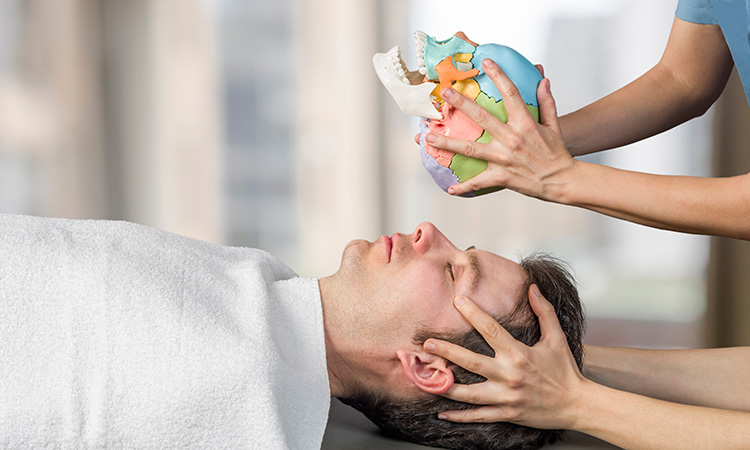
CranioSacral Therapy is a light-touch approach that has a direct impact on the overall nervous system. The nervous system registers and sends signals when the body is in dysfunction, causing the person to feel pain. Through gentle touch, generally no greater than five grams, or the weight of a nickel, the practitioner’s touch interacts with the client’s nervous system.
This light touch allows the body to stay within the parasympathetic mode of healing of rest, digest and repair. When the nervous system is in the parasympathetic mode the body can relax, repair and release restrictions within the system that signal pain.
The Craniosacral Rhythm
CranioSacral Therapy works with the whole system: body, mind and spirit. This allows the client to get to the root cause of their complaints and return to optimal function, reducing pain. Each cell has a consciousness and memory, with an innate wisdom to return to a more balanced being.
What is the mechanism that makes all this work? John E. Upledger, DO (1932-2012), founder of CranioSacral Therapy, came up with a “pressurestat” model that best describes this work. Within this model, the brain produces cerebrospinal fluid that cushions, protects and nourishes the brain and spinal cord.
Then, the majority of the fluid drains out via the jugular vein. He found that in adults, this cycle of fluid production and drainage occurs at six to 12 cycles per minute. This is called the craniosacral rhythm.
You can palpate this craniosacral rhythm at various parts of the body and head. As the fluid moves down the spinal canal toward the feet, there is a widening of the bones in the head, external rotation of the paired bones in the extremities, and flexion of the single bones. When the fluid moves up the spinal canal toward the head, there is a narrowing of the bones in the head, internal rotation of the bones in the extremities, and extension of the single bones.
Therefore, during an initial assessment and based on these movements, a CranioSacral Therapist can evaluate and feel if the craniosacral rhythm’s symmetry, rate, quality and amplitude are within the expected ranges.
If the craniosacral rhythm is slow or fast, feels sluggish in nature, or seems to be of higher amplitude on one side of the body than the other, this indicates something is happening to that area of the body. For example, with one of my clients, Margaret (name changed), I found the right hip to be at four cycles per minute, sluggish in nature, and not in symmetry with the left hip. This indicated to me something was happening with the right hip that impacted the client’s overall wellness.
CranioSacral Therapy and the Fascial System
The therapist would then proceed to use the five grams of pressure or less to start. As Upledger found, using more than five grams of pressure can signal the nervous systems response to go into protection mode versus rest-digest-repair mode. Through CranioSacral Therapy the goal is to work with the client’s nervous system to allow their body to make changes.
With five grams or less, CranioSacral Therapy connects with the fascial system, as every part of the body is interconnected through fascia. Fascia is a network in which you can travel within the body from head to toe. It allows connection and communication between bones, muscles, organs, veins, arteries, nerves, brain and spinal cord.
Through light touch, fascia begins to change, soften and move. The body remembers where it has been and where it wants to go. Our body is continually seeking to find balance and harmony. CranioSacral Therapy allows tissue to disorganize itself from whatever may be there, such as scar tissue, results from an old injury or adhesions, and lets the tissue reorganize itself in a new way. There is an innate trust in the inner wisdom of the body to do this.
Upledger called this inner wisdom, or inner physician, the part of us that knows. We all have this part within ourselves, and it assists in healing.
As the fascia disorganizes itself from its old holding pattern, it allows the surrounding tissue and bones to move in a different way. It can allow more space for nerves to move freely if they were pinched or impacted; it allows organs to move back into place if they were being compacted from an injury; it allows discs within the spinal canal to open and move with greater ease; it provides more room for the brain to move around if any of the cranial bones are compressed or out of sync. All of this leads to less pain experienced by the client.
With my client Margaret, as the fascia around her right hip softened it allowed the sacrum to drop and move into place, L4/L5 conjunction to open up space for the nerve roots, the dural tube running along the spinal canal to move with greater ease and not pull on the cranium, and the cranial bones to shift back into midline. This correlates with the initial complaints from the client of hip pain, low-back pain and headache.
Somato Emotional Release
When working with the tissue, an old memory may arise within a client. Margaret, for example, mentioned during the session that all of a sudden she remembered something from 10 years prior, when she slipped and fell on ice but did not think of it until just now. She began to cry. This is called somato emotional release. According to Upledger, the body can store memories and emotions from previous events, which can contribute to physical pain.
Margaret went on to describe how she had been alone and did not feel supported at that time in her life. So, I asked what the right hip needed. The right hip needed to be heard, to be listened to in a supportive way and to feel safe.
Therefore, she was able to give those to her right hip. After her fall, the rest of the body had to accommodate and was upset too. So, the client was able to dialogue with the rest of the body as well. All parts were able to forgive each other, understand each other, and decide to now work as a team.
At the end of the session, I re-evaluated Margaret’s craniosacral rhythm. The right hip was now in synchrony with the left hip, both being at eight cycles per minute. The rhythm also changed in quality, as now it was smooth. The parietal bones were no longer compressed and pulling on the system.
The Body Moves Forward
This is how CranioSacral Therapy works to help relieve pain. It helps lessen the pain by freeing up the physical structures being impacted by an injury—current or old—an accident or disease. CranioSacral Therapy allows the mind to relax through light touch as it drops into the parasympathetic mode of the nervous system.
CranioSacral Therapy helps the emotional body-mind-spirit release stored emotions that may also contribute to pain, giving them a voice to be heard and acknowledged, and to find resolution within. Overall, the client’s body is then able to move forward with greater ease, function and mobility.

About the Author
Rob Fournier, OTR, CST-D, joined the Upledger Institute International clinic as a clinic therapist with more than 24 years of experience in occupational therapy, Craniosacral Therapy, and Sensory Integration. His career has allowed him to practice in multiple settings of helping to start a sensory integration clinic, school settings, home care and co-owning wellness centers. He wrote this article on behalf of Upledger Institute International.